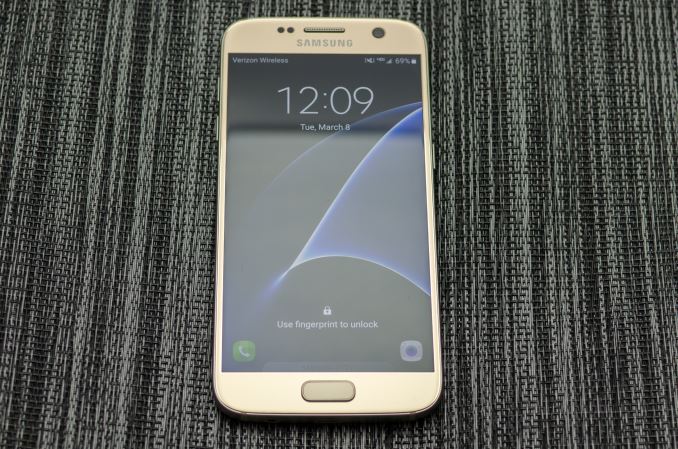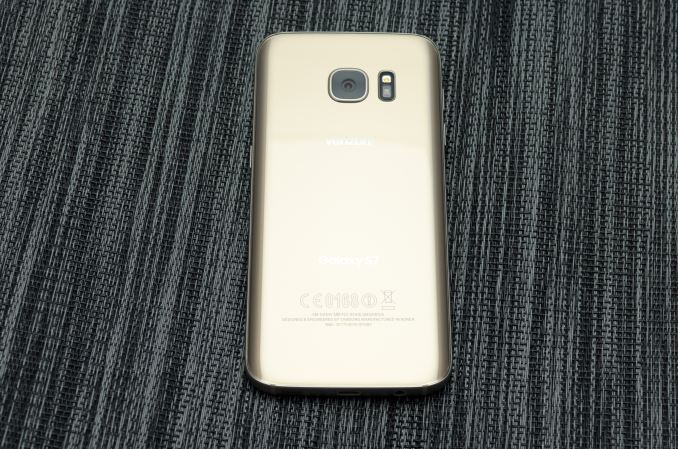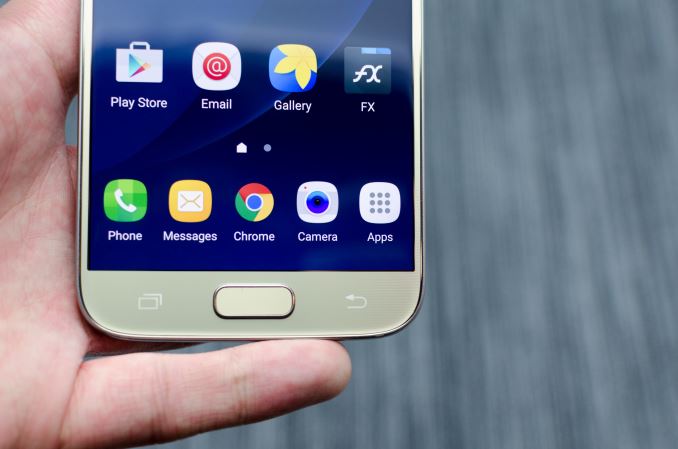The Samsung Galaxy S7 & S7 Edge Review, Part 1
by Joshua Ho on March 8, 2016 9:00 AM ESTInitial Conclusions
Even though we’re just barely scratching the surface of what we can test, the results we already have show quite a bit about the Samsung Galaxy S7. The Galaxy S line remains one of the most popular Android smartphones, and if history is any indication we can get a pretty good idea about what to expect for 2016 just by looking at the Galaxy S7 and S7 edge.
The first place we can start is design, and here we can see that the Galaxy S7 is decidedly an evolution of the Galaxy S6’s ID. However, pretty much every sharp edge has been rounded out to make the device more comfortable in the hand. The device has also been thickened in order to handle the larger battery and reduce the apparent z-height of the camera. The display size of the Galaxy S7 (non-edge) stays at 5.1 inches, and given how long Samsung has stuck to this display size it’s likely that they will be staying at this size for quite some time for their flagship.
In general, it feels like the industry has settled upon a display size somewhere between 5 to 5.5 inches for their flagship devices as going further probably won’t make a lot of sense for ergonomic reasons. I suspect Samsung and many other Android OEMs are settling into an Apple-like 2 year cadence for industrial and material design as replacement cycles lengthen, especially in the United States where subsidized phones have been almost entirely eliminated.
Meanwhile, though we haven’t had the time to run our full suite of battery life benchmarks, the data that we do have is quite interesting. At the very least, it looks like the Galaxy S7 will be a solid upgrade for those coming from the Galaxy S6 and earlier with a 15% bump in battery life or so. Anyone using a phone with an SoC not on a FinFET node will see even bigger gains to battery life, which is impressive to say the least. If you have any device with a Snapdragon 810 or 808 SoC, you’re definitely going to see major gains if you move to any device with a SoC fabricated on a FinFET node.
In terms of SoC performance, the Snapdragon 820 doesn't disappoint. In the time since testing the MDP it seems that between Qualcomm, Samsung, and Google, the trio has finally been able to optimize Snapdragon 820 for Chrome, so performance there is quite acceptable now and a pretty solid uplift over something like the Exynos 7420 or Snapdragon 810. GPU performance is also pretty much right where the Snapdragon 820 MDP was, so performance should be a good step above the A9's GT7600 GPU. Of course, we have yet to consider the power efficiency or sustainability of this performance, but turbo/overdrive performance is always relevant in the mobile space considering just how bursty almost every mobile workload is. It's pretty safe to say that Qualcomm has at least regained their footing in the SoC space, and with future SoCs they may well come to dominate the high end for performance and power once again. For now, it's looking like the race between Exynos 8890, Snapdragon 820, and Kirin 950 will be quite close.
For storage performance, to some extent it seems that the performance gains are relatively small, as the UFS 2.0 storage solutions on the Galaxy S6 and S7 are relatively similar. It’s interesting to see here that despite the now-mandatory use of FDE, the delta in performance between the Galaxy S6 and S7 in storage performance doesn’t seem to exist. This is welcome news as it wasn’t all that long ago that FDE for Android had a noticeable effect on storage performance.
On the display side, again we can see that the Galaxy S7 has a relatively similar display to the Galaxy S6. Calibration should be relatively good across the board, and AMOLED retains all of its traditional advantages including high contrast, support for wide color gamuts, low transition time, and improved power efficiency at lower average picture levels. Peak brightness is the only noticeable area where things seem to change, but I suspect that this will vary noticeably depending upon the unit. The one issue that I continue to notice here is that the edge display on the Galaxy S7 edge has a green tint at the edges, likely due to the diamond PenTile subpixel arrangement.
On the software side, Samsung’s TouchWiz UI continues to be more of the same when compared to the Galaxy Note5. The edge features continue to be somewhat interesting, but I continue to find myself thinking that there would be no difference if the same feature was implemented on the non-edge variant. Thankfully, the lag that I noticed last month in my initial hands-on time with the device seems to just have been a function of pre-release software, as the Galaxy S7 is relatively performant here. Although I’m not sure I’d go as far as to say that the Galaxy S7 is entirely free of lag. I suspect that Samsung has to balance power efficiency and responsiveness to some extent here, as while devices like the Nexus 5 can feel incredibly smooth and responsive there are very real knock-on effects in terms of practical battery life.
I’m also looking forward to testing features like Samsung Pay that are finally being deployed to the extent that I can use my personal credit card with Samsung Pay on my phone. However, out of the box TouchWiz still has some issues with an overly-neon theme, and in general things like Always-On Display already feel like they aren’t quite executed as well as they should be. I also noticed that the fingerprint scanner performance is strongly influenced by initial setup if I didn’t scan some areas on initial setup they never seemed to work very well unless I retrained the finger.
As for making a choice between the Galaxy S7 edge and Galaxy S7, there basically aren't any outside of size for the most part. There is the edge display, but by and large it feels like that's more of an aesthetic choice than a functional one. As we have seen you do get better battery life in the Galaxy S7 edge, but I don't feel like it makes sense to cross-shop the two. If you want one-handed usability, the Galaxy S7 is the only choice that makes sense. If you want a phablet, the Galaxy S7 edge is the only choice that makes sense.
Overall, I think the Galaxy S7 is looking to be one of the better devices of the year. Of course, there’s still a lot more to test, but the initial indications are already looking quite good. If you absolutely want the Galaxy S7 now, I don’t think there will be any major showstoppers present in this phone. However, if you’re looking to buy the best phone possible available this year I think it’s still too early to say where the chips will fall as Samsung's eager competitors have their own flagship phones right around the corner.














202 Comments
View All Comments
TheinsanegamerN - Wednesday, March 9, 2016 - link
It will let us know if throttling is a big issue. Benchmarks are just that, tests to see how well the phone does.Of course we dont run benches all day, but if you do not run benches, then how do you know how well the phone does when pushed, in say, a mobile game like asphalt 8 for more than 5 minutes? It's useful information to have.
tuxRoller - Saturday, March 12, 2016 - link
Well then, according to that measure, throttling is a big issue with the iPhone 6s.How do you tell how well it works with asphalt 8? I'd probably pay asphalt 8 for awhile.
These benchmarks aren't a good proxy as they are designed to push the devices to their limits.
tuxRoller - Tuesday, March 8, 2016 - link
Also, XDA ran some graphics tests continuously if you're interested.All of the phones throttled, save the note 5.
frenchy_2001 - Tuesday, March 8, 2016 - link
here is the xda article:http://www.xda-developers.com/s7-edge-throttling-t...
Note that the note5 did not throttle in GPU test, but its final run was still only 60% of the throttled S7 score (and about 50% of the starting score).
tuxRoller - Tuesday, March 8, 2016 - link
I just mentioned that it didn't throttle since jjj seems to be an exynos fan, so I was trying to forestall "BUT THE EXYNOS DIDN'T THROTTLE", even though it had lower results throughout.gijames1225 - Tuesday, March 8, 2016 - link
Great write up. Glad to see the Snapdragon 820 is properly flagship level. I look forward to the rest of the review, details on throttling, and hopefully at some point a look at Samsungs new Exynos SoC in the other s7 model.Drumsticks - Tuesday, March 8, 2016 - link
It's kind of interesting that Apple has a solid win in CU performance against Qualcomm, but a loss in GPU, even though they get their GPU from a company who should specialize in them. Twister truly is an astounding architecture, but they're probably at the end of the easy, huge performance boosts. It may be interesting to see how well Apple can go about completely redesigning their core when it happens.name99 - Tuesday, March 8, 2016 - link
Faster GPU is not as interesting as faster CPU because it's trivial to make a faster GPU --- just throw more GPU "cores" at the problem. If Apple wanted to double the GPU performance of the A9 tomorrow, all they have to do is use 12 GT7000 cores instead of their current 6.So the decision as to how many to use is an economic/use case decision, not a technical one. Given the pixels Apple is interested in driving, it looks like they used the right number of cores. QC sells into a broader market (and, in particular, a market that, whether or not it makes sense, uses crazy-high pixel densities) so their incentives align with throwing in more cores.
If you want to run a technically interesting GPU performance competition between Apple and Adreno (or Mali, or anyone else), raw performance is not the interesting metric. The interesting metrics are
- performance/watt
- performance/mm^2
I don't know who would win either of these, but my guess is Apple. We don't yet have enough information to answer the first question, but the mutterings about GPU throttling in the comments suggest that QC gets hig GPU numbers by burning lotsa power, not by having some super-advanced GPU that's a cleverer design than anyone else. In a sense, what you're seeing is what Apple could copy if they wanted by putting the A9X inside the iPhone6S.
lilmoe - Tuesday, March 8, 2016 - link
" The interesting metrics are- performance/watt
- performance/mm^2"
Nah, the really interesting metric would be how much power consumes to run (and sustain) the average game at 60FPS at the same resolution. Read: efficiency.
sor - Tuesday, March 8, 2016 - link
Efficiency... So performance/watt.